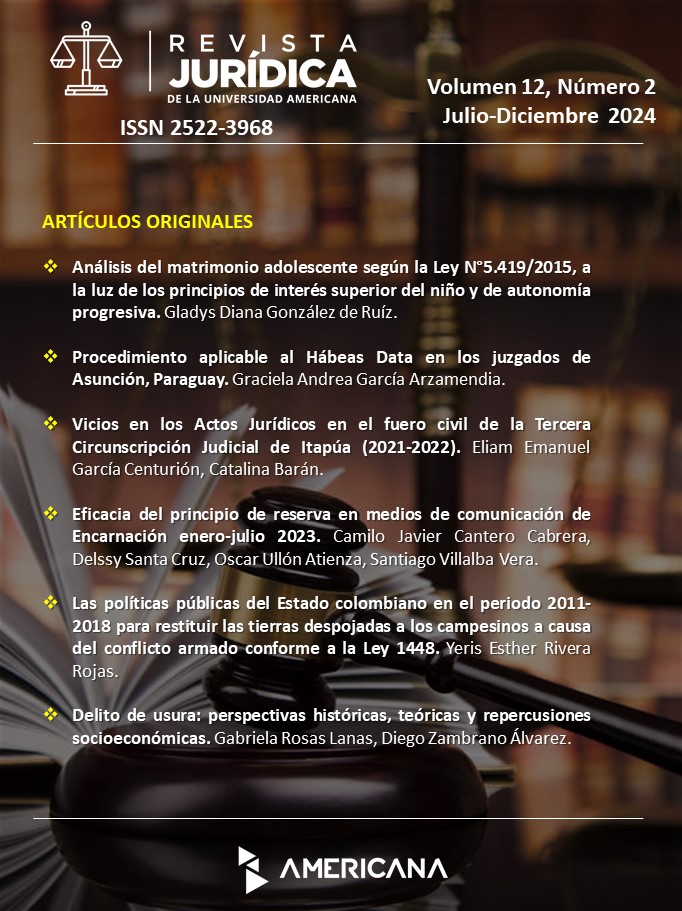Analysis of teenage marriage according to Law No. 5,419/2015, in light of the principles of the best interest of the child and progressive autonomy
DOI:
https://doi.org/10.30545/juridica.2024.jul-dic.1Keywords:
Teenage marriage, best interests of the child, progressive autonomy, Law No. 5419/2015, ParaguayAbstract
The research aims to analyze to what extent teenage marriage affects the principles of the best interests of the child and progressive autonomy laid down in article 20 of Law No. 5.419/2015. Child marriages and early and forced unions (CMEFU) are defined as any union, formal or informal, in which one or both parties are under 18 years of age (United Nations Population Fund [UNFPA] and Plan International Paraguay, 2021). It is a problem with sociocultural, educational, economic, legal, and health dimensions, among others, that faces weak public institutions, lack of access to rights and lack of protection for a large proportion of girls, boys and adolescents; and it embodies one of the types of violence towards childhood and adolescence. The research method that is adopted is of the empirical type, with a mixed approach and the design adopted is concurrent triangulation (DITRIAC). The documents studied include reports from the National Institute of Statistics, from a Civil Registry of the City of Saltos del Guairá and responses provided by judges of the juvenile court, court clerk and civil registry officer.
Downloads
References
Comité CEDAW. (18 de diciembre de 1979). Convención sobre la eliminación de todas las formas de discriminación contra la mujer. Naciones Unidas. https://ww w.ohchr.org/sites/default/files/Documen ts/ProfessionalInterest/cedaw_SP.pdf
Comité de los Derechos del Niño. (2013). Observación general Nº 14 (2013) sobre el derecho del niño a que su interés superior sea una consideración primordial (artículo 3, párrafo 1). Naciones Unidas. https://ciudadesa
migas.org/wp-content/uploads/2022/
/14_observacion-general-14-principio-interes-superior-2013-.pdf
Comité de los Derechos del Niño. (2016). Observación general núm. 20 (2016) sobre la efectividad de los derechos del niño durante la adolescencia. Naciones Unidas. https://ciudadesamigas.org/wp- content/uploads/2022/11/20_observaci on-general-20-aplicacion-derechos-nino-nina-durante-la-adolescencia- 2016.pdf
Constitución de 1967 (25 de agosto de 1967) https://reformaspoliticas.org/wp-conten
t/uploads/2015/03/paraguayconstitucion1967.pdf
Constitución Nacional del Paraguay. (20 de junio de 1992). Asunción, Paraguay: Gaceta Oficial. https://www.bacn.gov.py/leyes-paraguayas/9580/constitucion-nacional-
Corte Suprema de Justicia. (2019). El interés superior del niño. Tomo III. Asunción: Instituto de Investigaciones Jurídicas (IIJ). https://www.pj.gov.py/ebook/
libros_files/interes-superior-del-nino-tomoIII.pdf
Díaz Pantoja, J. (2023). Entre la autonomía progresiva y el interés superior del niño y de la niña. Una mirada holística a los derechos de la niñez y la adolescencia. edUPV. https://riunet.upv.es/bitstream/
handle/10251/191967/6371.pdf?sequence=1&isAllowed=yhttps://riunet.upv.es/bitstream/
handle/10251/191967/6371.pdf?sequence=1&isAllowed=y
Ferrero, A., & De Andrea, N. (2020). Autonomía progresiva y consentimiento informado en menores de edad en el nuevo código civil y comercial argentino. Desafíos para la psicología. Anuario de Investigaciones, XXVII, 431-435. https://www.reda lyc.org/comocitar.oa?id=369166429050
CEPAL. (2021). Los matrimonios y uniones infantiles, tempranos y forzados: prácticas nocivas profundizadoras de la desigualdad de género en América Latina y el Caribe. Documento de Proyectos (LC/TS.2021/186). Grupo de trabajo del programa conjunto interinstitucional para poner fin al matrimonio infantil y a las uniones tempranas en América Latina y el Caribe https://oig.cepal.org/sites/default/files/c2100897_web.pdf
Gómez De La Torre Vargas, M. (2018). Las implicancias de considerar al niño sujeto de derechos. Revista de Derecho (18), 117-137. https://doi.org/10.22235/
rd.v18i2.1703
Ley N° 5419. (2015). Que modifica los artículos 17 y 20 de la ley N° 1/92 De reforma parcial del Código Civil. 11 de mayo de 2015. https://www.bacn.gov.py/leyes-paraguayas/4409/ley-n-5419-modifica-los-articulos-17-y-20-de-la-ley-n-192-de-reforma-parcial-del-codigo-civil#:~:text=%2D%20Los%20menores%20a%20partir%20de,con%20el%20consentimiento%20del%20otro.
Ley Nº 1680. (2001). Código de la niñez y la Adolescencia. 04 de junio de 2001. https://www.bacn.gov.py/leyes-paraguayas/5261/codigo-de-la-ninez-y-la-adolescencia.
Ley N° 57. (1990). Que aprueba y ratifica la Convención de las Naciones Unidas sobre los Derechos del Niño en Paraguay. https://www.csj.gov.py/
cache/lederes/P-0-20121990-L-57-1.pdf
Ley N° 903/1981 Código del Menor (18 de diciembre de 1981). https://archive.crin.org/es/biblioteca/buscar-legislaci%C3%B3n/paraguay-codigo-del-menor-ley-no-903/81.html
Ramírez Candia, M. D. (2016). Derecho Constitucional Paraguayo. Tomo I. Litocolor. https://www.bacn.gov.py/
leyes-paraguayas/9580/constitucion-nacional-
Sala Constitucional. (16 de octubre de 2013). Declara la nulidad parcial del artículo 46 del Código Civil, y establece que la edad mínima para contraer matrimonio es la de 16 años, tanto para hombres como mujeres. Exp. N°10-0161. https://oig.cepal.org/sites/d
efault/files/2014_sentencia1353_ven.pdf
Torrecuadrada García-Lozano, S. (2016). El Interés superior del niño. Anuario Mexicano de Derecho Internacional, 26, 131-157. https://revistas.juridicas.u
nam.mx/index.php/derecho-internacional/article/view/523/783
UNFPA & Plan International Paraguay. (2021). Invisibles a plena luz. Uniones Tempranas y Forzadas en Paraguay. Asunción: UNFPA. https://paragu
ay.unfpa.org/es/publications/invisibles-plena-luz-uniones-tempranas-y-forzadas-en-paraguay
UNICEF. (2006). Convención sobre los Derechos del Niño. UNICEF/Nuevo Siglo. https://www.unicef.org/es/
convencion-derechos-nino/texto-convencion







